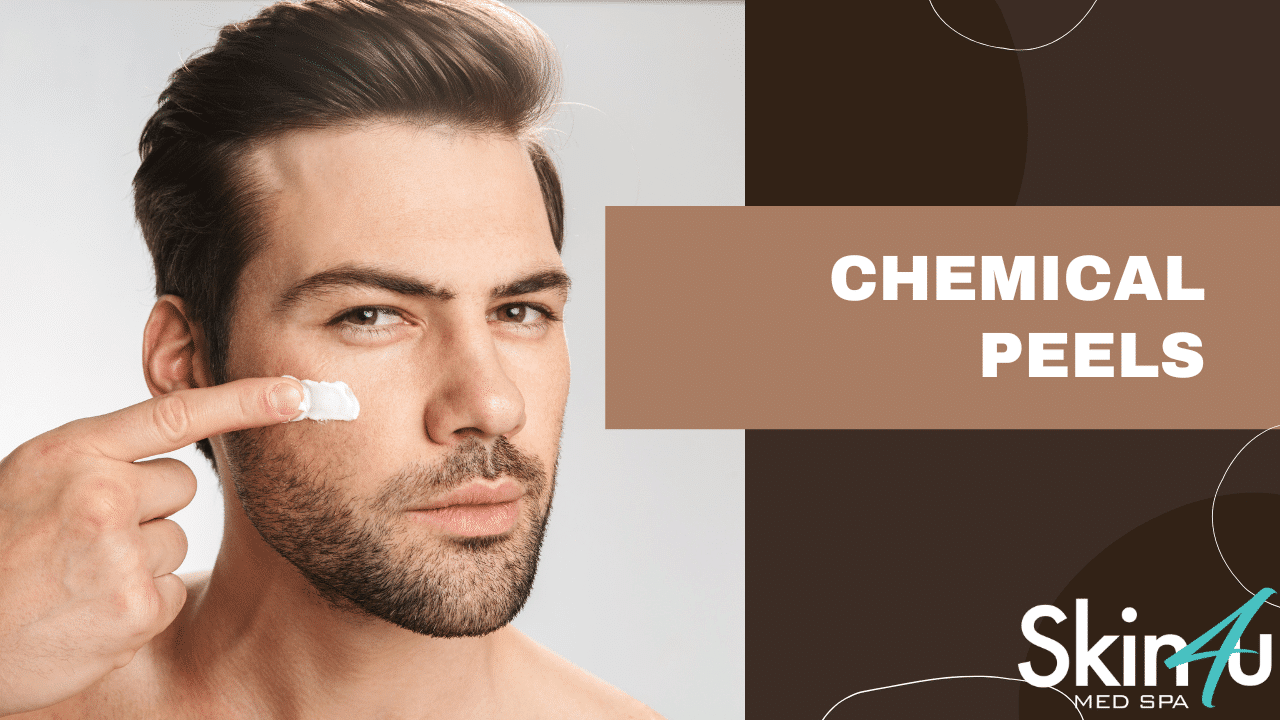
Chemical peels have become a popular solution for individuals seeking to revitalize their skin and address various concerns, including skin pigmentation irregularities and uneven texture (1). Specifically, this cosmetic treatment involves applying a chemical solution to the skin, which induces exfoliation and reveals a rejuvenated layer underneath. Furthermore, chemical peels can be customized to target specific concerns and improve the overall appearance of the skin (2).
How Chemical Peels Work
Chemical peels work by creating a controlled injury to the skin, prompting the shedding of dead skin cells and encouraging the growth of new, healthier cells. Importantly, the depth of a peel, which determines the level of exfoliation, depends on the type and concentration of the chemical solution used (3). Therefore, this process can be broken down into three phases:
- First: Application: The chemical solution is carefully applied to the skin.
- Second: Exfoliation: The solution induces controlled damage to the skin layers, leading to exfoliation.
- Third, and finally: Regeneration: New, healthier skin cells emerge, resulting in improved texture and appearance (3).
Types of Chemical Peels
Chemical peels are generally categorized into three main types: superficial, medium, and deep (4). Moreover, each type utilizes different chemical solutions to achieve varying depths of exfoliation:
- Superficial Peels: For instance, these peels use mild acids like alpha-hydroxy acids (AHAs), such as glycolic acid derived from sugarcane, and beta-hydroxy acids (BHAs), such as salicylic acid, to gently exfoliate the outermost layer of skin (epidermis) (5). Consequently, they are ideal for treating mild skin concerns such as fine lines, acne, and minor pigmentation irregularities (3).
- Medium Peels: In contrast, these peels penetrate deeper into the skin, reaching the middle and outer layers. Specifically, they typically use trichloroacetic acid (TCA) or glycolic acid to remove damaged skin cells (4). As a result, medium peels are effective in addressing moderate wrinkles, acne scars, and more significant pigmentation problems (3).
- Deep Peels: On the other hand, these peels penetrate the deepest, reaching the lower middle layer of skin. Often, they use phenol or trichloroacetic acid in higher concentrations to treat deep wrinkles, extensive sun damage, and severe scarring (4). Therefore, deep peels require more extensive pretreatment and aftercare (4). However, while typically performed once, deep peels may be repeated in certain cases to achieve optimal results, similarly to how medium peels may require a second application after 3 to 6 months (7).
Skin Type Considerations
The Fitzpatrick skin type scale is a crucial factor in determining the appropriate type of chemical peel for different individuals. In fact, this scale classifies skin types based on their response to sun exposure and their tendency to tan or burn (5).
Skin Type Description (I added this for formating)
- Type I: Very fair skin, always burns, never tans
- Type II: Fair skin, usually burns, tans minimally
- Type III: Medium skin, sometimes burns, tans gradually
- Type IV: Olive skin, rarely burns, tans easily
- Type V: Brown skin, tans very easily, rarely burns
- Type VI: Dark brown or black skin, never burns, tans very easily
Generally speaking, individuals with lighter skin types (I-III) may be more suitable for superficial or medium peels, while, in contrast, those with darker skin types (IV-VI) may require more cautious approaches to minimize the risk of post-inflammatory hyperpigmentation (darkening of the skin) (5).
Benefits of Chemical Peels for Skin Pigmentation
Chemical peels offer several benefits for individuals with skin pigmentation concerns, such as age spots, sunspots, melasma, and uneven skin tone (4).
- Exfoliation and Skin Renewal: First and foremost, chemical peels accelerate the natural exfoliation process, removing the damaged outer layers of skin that contain excess pigment. Consequently, this reveals a fresher, brighter complexion with a more even skin tone.
- Reduced Hyperpigmentation: Secondly, by removing the top layers of skin, chemical peels can effectively reduce the appearance of hyperpigmentation, including dark spots, age spots, and melasma (2).
- Stimulated Collagen Production: Furthermore, some chemical peels can stimulate collagen production, which helps improve skin elasticity and firmness, thus further enhancing the overall appearance of the skin (2).
Benefits of Chemical Peels for Skin Texture
In addition to improving skin pigmentation, chemical peels can also significantly enhance skin texture (6).
- Smoother Skin: Primarily, chemical peels effectively remove dead skin cells and promote cell turnover, thereby leading to smoother and softer skin (8).
- Reduced Roughness and Unevenness: Moreover, by exfoliating the skin, chemical peels can minimize the appearance of rough patches, uneven texture, and fine lines, resulting in a more refined complexion (8).
- Improved Acne and Scarring: Additionally, chemical peels can be beneficial for individuals with acne-prone skin. Specifically, they help unclog pores, reduce blackheads, and minimize breakouts. Indeed, studies have shown significant improvement in acne lesions, including comedones, papules, and pustules, with the use of glycolic acid peels (9). Furthermore, chemical peels can improve the appearance of acne scars by promoting skin regeneration (3). Also, chemical peels have also been shown to be effective in treating melasma, a common skin condition characterized by brown or grayish-brown patches on the face (9).
Side Effects and Risks of Chemical Peels
Although generally safe when performed by a qualified professional, chemical peels can have potential side effects and risks (10).
- Redness, Swelling, and Scabbing: Typically, these are common side effects that usually subside within a few days to weeks, depending on the depth of the peel (10).
- Changes in Skin Color: Occasionally, chemical peels can cause temporary or permanent changes in skin color, such as hyperpigmentation (darkening) or hypopigmentation (lightening) (10).
- Scarring: Rarely, but importantly, scarring can occur, especially with deeper peels (10).
- Infection: Furthermore, there is a risk of infection after a chemical peel, so it’s crucial to follow proper aftercare instructions (10).
- Sun Sensitivity: After a chemical peel, because the skin becomes more sensitive to the sun, it’s essential to use sunscreen diligently (7).
- Healing Time: Finally, the time it takes for the skin to heal after a chemical peel varies depending on the type of peel. For example, light peels typically heal within a few days, while medium peels may take up to a week. In contrast, deep peels can take several weeks for complete healing (7).
Real-Life Experiences
One individual shared their experience of undergoing a chemical peel to address skin concerns such as enlarged pores, hormonal breakouts, and discoloration. Specifically, they described the process, which involved the application of a chemical solution tailored for melanated skin to minimize the risk of hyperpigmentation or hypopigmentation (11). Furthermore, the individual documented their healing process, noting that the peeling started around day two or three and continued for several days. Importantly, they emphasized the importance of aftercare, including sun protection and avoiding picking or pulling at the skin (11). While they acknowledged that their skin might not look drastically different, they expressed satisfaction with the overall improvement in texture and clarity (11).
Aftercare for Chemical Peels
Proper aftercare is crucial for optimal healing and results after a chemical peel (10).
- Sun Protection: First, avoid sun exposure as much as possible, and use a broad-spectrum sunscreen with an SPF of 30 or higher to protect the newly exposed skin. This is crucial because the new skin is more susceptible to sun damage, which can lead to premature aging and other skin issues in the long term.
- Gentle Cleansing: Second, use a mild, soap-free cleanser and lukewarm water to cleanse the treated area. Therefore, avoid scrubbing or harsh exfoliants (12).
- Moisturization: Third, keep the skin well-hydrated by applying a gentle, fragrance-free moisturizer as needed.
- Avoid Picking or Scratching: Furthermore, refrain from picking, scratching, or rubbing the treated skin, as this can interfere with healing and increase the risk of scarring (13).
- Follow Doctor’s Instructions: Finally, and most importantly, adhere to the specific aftercare instructions provided by your dermatologist or esthetician (10).
Conclusion
Chemical peels can be a valuable treatment option for individuals seeking to improve their skin’s appearance, particularly those concerned with pigmentation irregularities and uneven texture. Indeed, these treatments offer a range of benefits, from reducing hyperpigmentation and fine lines to improving acne and overall skin tone. However, it’s essential to carefully consider the different types of chemical peels, their potential side effects, and the required aftercare to make an informed decision. Therefore, consulting with a qualified dermatologist or esthetician is crucial to determine the most suitable type of peel based on individual skin type, concerns, and desired outcomes (6). In conclusion, by understanding the process and taking necessary precautions, individuals can achieve significant improvements in their skin’s health and appearance with chemical peels.




